
Wasps in the family Pompilidae are commonly called spider wasps, spider-hunting wasps, or pompilid wasps. The family is cosmopolitan, with some 5,000 species in six subfamilies. Nearly all species are solitary, and most capture and paralyze prey, though members of the subfamily Ceropalinae are kleptoparasites of other pompilids, or ectoparasitoids of living spiders.
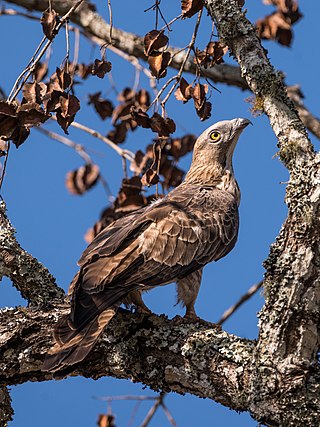
The crested honey buzzard is a bird of prey in the family Accipitridae, which also includes many other diurnal raptors such as kites, eagles, and harriers. Pernis ptilorhynchus has six subspecies. As a medium-sized raptor, their size ranges between 57–60 cm (22–24 in). They are also known as the Oriental, Asiatic, or Eastern honey buzzard. The name is derived from its diet, which consists mainly of the larvae of bees and wasps extracted from honey combs.
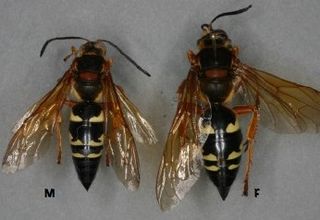
Sphecius speciosus, often simply referred to as the cicada killer or the cicada hawk, is a large, solitary digger wasp species in the family Crabronidae. The name may be applied to any species of crabronid that preys on cicadas, though in North America, it is typically applied to this species, also referred to as the eastern cicada killer in order to further differentiate it from the multiple other examples of related wasp species. Sometimes, they are called sand hornets, although they are not hornets, which belong to the family Vespidae. This species can be found in the Eastern and Midwest U.S. and southwards into Mexico and Central America. They are so named because they hunt cicadas and provision their nests with them. Cicada killers exert a measure of natural control on cicada populations, and as such, they may directly benefit the deciduous trees upon which the cicadas feed.

The Asian giant hornet or northern giant hornet, including the color form referred to as the Japanese giant hornet, is the world's largest hornet. It is native to temperate and tropical East Asia, South Asia, Mainland Southeast Asia, and parts of the Russian Far East. It was also found in the Pacific Northwest of North America in late 2019 with a few more additional sightings in 2020, and nests found in 2021, prompting concern that it could become an invasive species. However, by the end of the season in November 2022, there were no confirmed sightings in North America at all, suggesting they may have been eradicated in that region.

Mud dauber is a name commonly applied to a number of wasps from either the family Sphecidae or Crabronidae which build their nests from mud; this excludes members of the family Vespidae, which are instead referred to as "potter wasps". Mud daubers belong to different families and are variable in appearance. Most are long, slender wasps about 1 inch (25 mm) in length. The name refers to the nests that are made by the female wasps, which consist of mud molded into place by the wasp's mandibles. Mud daubers are not normally aggressive, but can become belligerent when threatened. Stings are uncommon.

Rhopalosomatidae is a family of Hymenoptera containing about 68 extant species in four genera that are found worldwide. Three fossil genera are known.
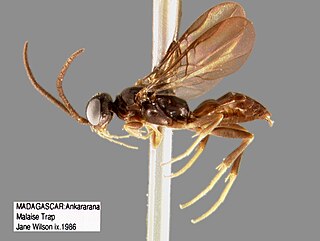
Heterogynaidae is a minor and disputed lineage of small spheciform wasps occurring in Madagascar, Botswana, Turkmenistan, Oman, the United Arab Emirates, and the Eastern Mediterranean area. The majority are dark in color and range in size from approximately 1.5 to 5.0 mm. Most specimens have been collected in arid climates, but one species from Madagascar is known to occur in a humid forest habitat. Although males have functional wings, heterogynaid females are typically brachypterous, a trait which is unique among spheciform wasps. Wing venation is reduced in both sexes. All species are diurnal, with the exception of H. nocticola. Other aspects of their biology are completely unknown, but details of their morphology have prompted researchers to hypothesize that they may be non-fossorial parasitoids adapted to hunt in tight spaces, such as under tree bark. This is speculative and has not yet been confirmed by actual observations of behavior. It is also possible that modifications of the female metasomal tergum VI and gonostyli may represent a unique prey transport mechanism, but this is also unconfirmed.
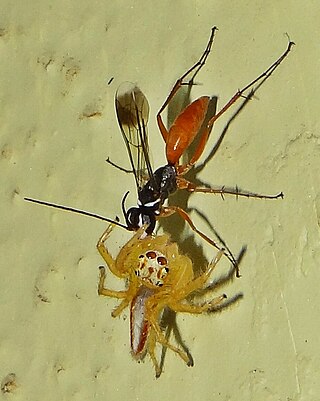
Mass provisioning is a form of parental investment in which an adult insect, most commonly a hymenopteran such as a bee or wasp, stocks all the food for each of her offspring in a small chamber before she lays the egg. This behavior is common in both solitary and eusocial bees, though essentially absent in eusocial wasps.

A wasp is any insect of the narrow-waisted suborder Apocrita of the order Hymenoptera which is neither a bee nor an ant; this excludes the broad-waisted sawflies (Symphyta), which look somewhat like wasps, but are in a separate suborder. The wasps do not constitute a clade, a complete natural group with a single ancestor, as bees and ants are deeply nested within the wasps, having evolved from wasp ancestors. Wasps that are members of the clade Aculeata can sting their prey.

Chiasognathus grantii is a species of stag beetle found in Argentina and Chile. It is known as Darwin's beetle, Grant's stag beetle, or the Chilean stag beetle.
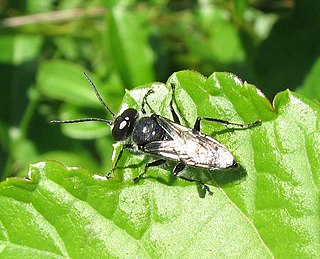
Astata is a cosmopolitan genus of solitary predatory wasps in the subfamily Astatinae. They are known to prey on adults and nymphs of Pentatomidae. Astata is the largest genus in this subfamily, and is identified by features of its wing venation. The males of this genus and the related genus Dryudella have very large compound eyes that broadly meet at the top of the head.

Sphecius grandis, also called the western cicada killer, is a species of cicada killer wasp (Sphecius). The western species shares the same nesting biology as its fellow species, the eastern cicada killer. S. grandis, like all other species of the genus Sphecius, mainly provides cicadas for its offspring. It forms nest aggregations and mates and broods once in a year, in July and early August. The wasp is on average 3 cm (1 in) to 5 cm (2 in) in length and is amber-yellow with yellow rings on its abdomen.
Dalara is a genus of wasp in the family Crabronidae, tribe Larrini.
Lynn Kimsey is an entomologist, taxonomist, director of the Bohart Museum of Entomology and professor of entomology at the University of California, Davis since 1989. Her specialties are bees and wasps; and insect diversity and evolution.

The Bohart Museum of Entomology was founded in 1946 on the campus of the University of California, Davis. The museum is currently the seventh largest insect collection in North America with more than seven million specimens of terrestrial and freshwater arthropods. At least 90% of these holdings are insects. The collection is worldwide in scope with the Western Hemisphere, Indonesia, and Australasia particularly well represented.
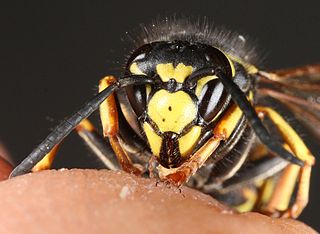
Vespula austriaca is an obligate parasitic wasp, parasitizing the nests of other species in the genus Vespula in the Old World. Its common host species include V. rufa in Europe, Japan, and East Siberia.V. austriaca wasps pollinate orchids.
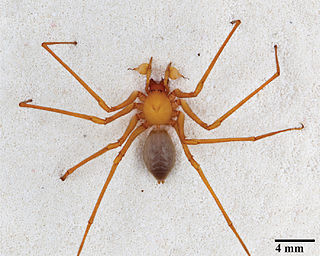
Trogloraptor is a genus of large spiders found in the caves of southwestern Oregon. It is the sole genus in the family Trogloraptoridae, and includes only one species, Trogloraptor marchingtoni. These spiders are predominantly yellow-brown in color with a maximum leg span of 3 in (7.6 cm). They are remarkable for having hook-like claws on the raptorial last segments of their legs.

The Thynnidae are a family of large, solitary wasps whose larvae are almost universally parasitoids of various beetle larvae, especially those in the superfamily Scarabaeoidea. Until recently, the constituents of this family were classified in the family Tiphiidae, but multiple studies have independently confirmed that thynnids are a separate lineage.

Brachycistidinae is a subfamily of the flower wasp family Tiphiidae that contains 10 genera and 85 species, and which is confined to the Nearctic zoogeographic region.

Omalus aeneus is a species of cuckoo wasps belonging to the family Chrysididae.



















